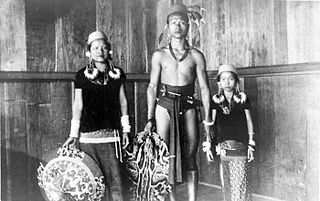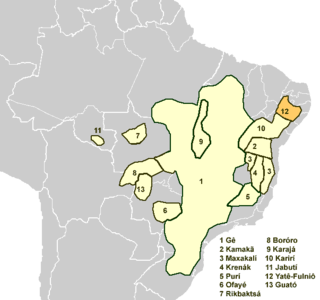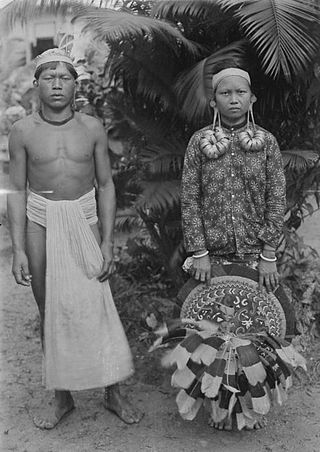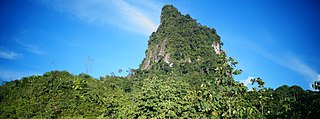Related Research Articles
Unless otherwise noted, statements in this article refer to Standard Finnish, which is based on the dialect spoken in the former Häme Province in central south Finland. Standard Finnish is used by professional speakers, such as reporters and news presenters on television.
Niuean is a Polynesian language, belonging to the Malayo-Polynesian subgroup of the Austronesian languages. It is most closely related to Tongan and slightly more distantly to other Polynesian languages such as Māori, Samoan, and Hawaiian. Together, Tongan and Niuean form the Tongic subgroup of the Polynesian languages. Niuean also has a number of influences from Samoan and Eastern Polynesian languages.
The phonology of Portuguese varies among dialects, in extreme cases leading to some difficulties in mutual intelligibility. This article on phonology focuses on the pronunciations that are generally regarded as standard. Since Portuguese is a pluricentric language, and differences between European Portuguese (EP), Brazilian Portuguese (BP), and Angolan Portuguese (AP) can be considerable, varieties are distinguished whenever necessary.
English phonology is the system of speech sounds used in spoken English. Like many other languages, English has wide variation in pronunciation, both historically and from dialect to dialect. In general, however, the regional dialects of English share a largely similar phonological system. Among other things, most dialects have vowel reduction in unstressed syllables and a complex set of phonological features that distinguish fortis and lenis consonants.

Hmong or Mong is a dialect continuum of the West Hmongic branch of the Hmongic languages spoken by the Hmong people of Sichuan, Yunnan, Guizhou, Guangxi, Hainan, northern Vietnam, Thailand, and Laos. There are an estimated 4.5 million speakers of varieties that are largely mutually intelligible, including over 280,000 Hmong Americans as of 2013. Over half of all Hmong speakers speak the various dialects in China, where the Dananshan (大南山) dialect forms the basis of the standard language. However, Hmong Daw and Mong Leng are widely known only in Laos and the United States; Dananshan is more widely known in the native region of Hmong.
The phonological history of English includes various changes in the phonology of consonant clusters.
Kambera, also known as East Sumbanese, is a Malayo-Polynesian language spoken in the eastern half of Sumba Island in the Lesser Sunda Islands, Indonesia. Kambera is a member of Bima-Sumba subgrouping within Central Malayo-Polynesian inside Malayo-Polynesian. The island of Sumba, located in Eastern Indonesia, has an area of 11,243.78 km2. The name Kambera comes from a traditional region which is close to the town of Waingapu in East Sumba Regency. Because of export trades which concentrated in Waingapu in the 19th century, the language of the Kambera region has become the bridging language in eastern Sumba.
Ancient Greek phonology is the reconstructed phonology or pronunciation of Ancient Greek. This article mostly deals with the pronunciation of the standard Attic dialect of the fifth century BC, used by Plato and other Classical Greek writers, and touches on other dialects spoken at the same time or earlier. The pronunciation of Ancient Greek is not known from direct observation, but determined from other types of evidence. Some details regarding the pronunciation of Attic Greek and other Ancient Greek dialects are unknown, but it is generally agreed that Attic Greek had certain features not present in English or Modern Greek, such as a three-way distinction between voiced, voiceless, and aspirated stops ; a distinction between single and double consonants and short and long vowels in most positions in a word; and a word accent that involved pitch.

The Kenyah people are an indigenous, Austronesian-speaking people of Borneo, living in interior North and East Kalimantan, Indonesia and Sarawak, Malaysia.

Inuktun is the language of approximately 1,000 indigenous Inughuit, inhabiting the world's northernmost settlements in Qaanaaq and the surrounding villages in northwestern Greenland.
Tamil phonology is characterised by the presence of "true-subapical" retroflex consonants and multiple rhotic consonants. Its script does not distinguish between voiced and unvoiced consonants; phonetically, voice is assigned depending on a consonant's position in a word, voiced intervocalically and after nasals except when geminated. Tamil phonology permits few consonant clusters, which can never be word initial.
The Uma Baka' tribe were originally from the rural center of Borneo Island. Originally from Bahau River, the Uma Baka' people began moved out from that river system along with the Uma' Kulit people in the 18th century. Although the tribe still remains in East Kalimantan, Indonesia, some of them have moved to Sarawak, Malaysia. The tribe was known as the best hunters in jungle. The Uma Baka' people are considered as a sub-ethnic of the Kenyah people and their language is Uma Baka' language, which is a form of Kenyah language dialect.
The Kenyah languages are a group of half a dozen or so closely related languages spoken by the Kenyah peoples of Borneo. They are:
The North Sarawakan languages are a group of Austronesian languages spoken in the northeastern part of the province of Sarawak, Borneo, and proposed in Blust.

Maʼya is an Austronesian language of the Raja Ampat islands in Southwest Papua, Indonesia. It is part of the South Halmahera–West New Guinea (SHWNG) subgroup and is spoken by about 6,000 people in coastal villages on the islands Misool, Salawati, and Waigeo, on the boundary between Austronesian and Papuan languages.

Fulniô, or Yatê, is a language isolate of Brazil, and the only indigenous language remaining in the northeastern part of that country. The two dialects, Fulniô and Yatê, are very close. The Fulniô dialect is used primarily during a three-month religious retreat. Today, the language is spoken in Águas Belas, Pernambuco.
Waurá (Wauja) is an Arawakan language spoken in the Xingu Indigenous Park of Brazil by the Waujá people. It is "partially intelligible" with Mehináku. The entire population speaks the language.

The Apo Kayan people are one of the Dayak people groups that are spread throughout Sarawak of Malaysia, North Kalimantan and East Kalimantan of Indonesia. The earliest Apo Kayan people are from the riverside of the Kayan River, Bulungan Regency, North Kalimantan, Indonesia. According to the Apo Kayan Dayak legend, the Kayan people are the forefathers of which all smaller sub-ethnic Dayak people that are found along the Kayan River came from. Today, the population of the Apo Kayan people are estimated about 64,900.
The phonology of Māori is typical for a Polynesian language, with its phonetic inventory being one of the smallest in the world with considerable variation in realisation. The Māori language retains the Proto-Polynesian syllable structure: (C)V(V ), with no closed syllables. The stress pattern is unpredictable, unlike in many other Polynesian languages.

Long Busang (Lobus) is a settlement in the rural area of Bukit Mabong, Sarawak, Malaysia. The Kenyah Badeng people dominate this settlement in Ulu Sungai Balui.